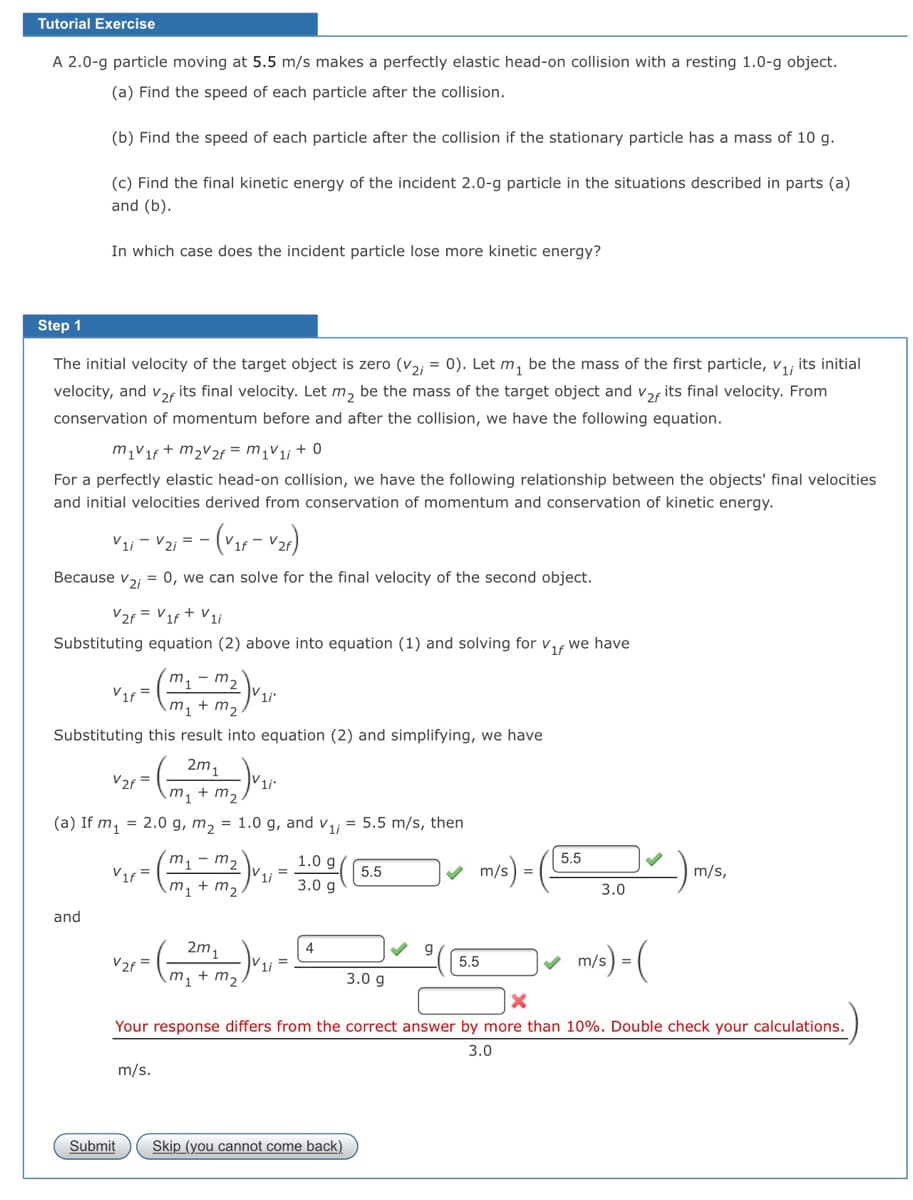(a) If m, = 2.0 g, m, = 1.0 g, and v = 5.5 m/s, then %3D m-m2 m, + m2. 1.0 g 5.5 5.5 3.0 g m/s) = m/s, 3.0 and 2m, 4 m/s) = 5.5 mi+ m2. 3.0 g Your response differs from the correct answer by more than 10%. Double check your calculations. 3.0 m/s.
(a) If m, = 2.0 g, m, = 1.0 g, and v = 5.5 m/s, then %3D m-m2 m, + m2. 1.0 g 5.5 5.5 3.0 g m/s) = m/s, 3.0 and 2m, 4 m/s) = 5.5 mi+ m2. 3.0 g Your response differs from the correct answer by more than 10%. Double check your calculations. 3.0 m/s.
College Physics
10th Edition
ISBN:9781285737027
Author:Raymond A. Serway, Chris Vuille
Publisher:Raymond A. Serway, Chris Vuille
Chapter6: Momentum And Collisions
Section: Chapter Questions
Problem 29P: a man of mass m1 = 70.0 kg is skating at v1 = 8.00 m/s behind his wife of mass m2 = 50.0 kg, who is...
Related questions
Question

Transcribed Image Text:Tutorial Exercise
A 2.0-g particle moving at 5.5 m/s makes a perfectly elastic head-on collision with a resting 1.0-g object.
(a) Find the speed of each particle after the collision.
(b) Find the speed of each particle after the collision if the stationary particle has a mass of 10 g.
(c) Find the final kinetic energy of the incident 2.0-g particle in the situations described in parts (a)
and (b).
In which case does the incident particle lose more kinetic energy?
Step 1
The initial velocity of the target object is zero (v2i
= 0). Let m, be the mass of the first particle, v,, its initial
velocity, and v2r its final velocity. Let m, be the mass of the target object and vr its final velocity. From
conservation of momentum before and after the collision, we have the following equation.
m V1f + m2v2f = m,V1 + 0
For a perfectly elastic head-on collision, we have the following relationship between the objects' final velocities
and initial velocities derived from conservation of momentum and conservation of kinetic energy.
-- ("x- v2)
V1i - V2i
Because v2, = 0, we can solve for the final velocity of the second object.
V2f = V1f+ V1/
Substituting equation (2) above into equation (1) and solving for v,, we have
m, - m,
Vif =
m, + m2
Substituting this result into equation (2) and simplifying, we have
2m1
V2f =
\m, + m2
(a) If m, = 2.0 g, m, = 1.0 g, and v = 5.5 m/s, then
m, - m2
1.0 g/
5.5
Vif =
m, + m2
m/s) =
5.5
m/s,
%3D
3.0 g
3.0
and
ms) = (
2m1
4
5.5
\m, + m2
3.0 g
Your response differs from the correct answer by more than 10%. Double check your calculations.
3.0
m/s.
Submit
Skip (you cannot come back)
Expert Solution
This question has been solved!
Explore an expertly crafted, step-by-step solution for a thorough understanding of key concepts.
Step by step
Solved in 2 steps

Knowledge Booster
Learn more about
Need a deep-dive on the concept behind this application? Look no further. Learn more about this topic, physics and related others by exploring similar questions and additional content below.Recommended textbooks for you

College Physics
Physics
ISBN:
9781285737027
Author:
Raymond A. Serway, Chris Vuille
Publisher:
Cengage Learning

Glencoe Physics: Principles and Problems, Student…
Physics
ISBN:
9780078807213
Author:
Paul W. Zitzewitz
Publisher:
Glencoe/McGraw-Hill

Physics for Scientists and Engineers: Foundations…
Physics
ISBN:
9781133939146
Author:
Katz, Debora M.
Publisher:
Cengage Learning

College Physics
Physics
ISBN:
9781285737027
Author:
Raymond A. Serway, Chris Vuille
Publisher:
Cengage Learning

Glencoe Physics: Principles and Problems, Student…
Physics
ISBN:
9780078807213
Author:
Paul W. Zitzewitz
Publisher:
Glencoe/McGraw-Hill

Physics for Scientists and Engineers: Foundations…
Physics
ISBN:
9781133939146
Author:
Katz, Debora M.
Publisher:
Cengage Learning

University Physics Volume 1
Physics
ISBN:
9781938168277
Author:
William Moebs, Samuel J. Ling, Jeff Sanny
Publisher:
OpenStax - Rice University

Principles of Physics: A Calculus-Based Text
Physics
ISBN:
9781133104261
Author:
Raymond A. Serway, John W. Jewett
Publisher:
Cengage Learning

Physics for Scientists and Engineers
Physics
ISBN:
9781337553278
Author:
Raymond A. Serway, John W. Jewett
Publisher:
Cengage Learning